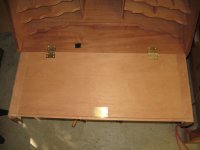Bob Seibels
Member
I am making the Glen Huey "New England Secretary" in mahogany, and am planning to actually use the desk for writing. I want to add a desk leather to the inside of the fall front, but I can't figure out where it should go (see photo). The fall front is ~ 36"L x 14"W. The hinges stick in 1-1/2" and the lock 2" from the edge, leaving only about 10" for the leather insert, which I think is too narrow. Should the leather be notched out for the hinges and lock? How close to the edge should it be? Should it also extend over to the other side? Or, should I forget this idea and just go with a writing pad. I really like the way desk leathers look, but I'm not sure working around the hardware is the way to go.

